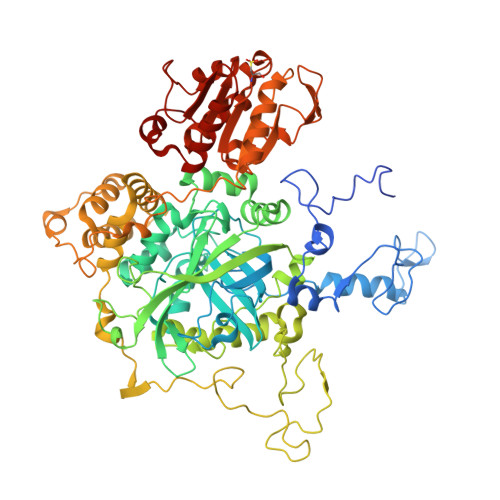Modulation of heme orientation and binding by a single residue in catalase HPII of Escherichia coli.
Jha, V., Louis, S., Chelikani, P., Carpena, X., Donald, L.J., Fita, I., Loewen, P.C.(2011) Biochemistry 50: 2101-2110
- PubMed: 21332158
- DOI: https://doi.org/10.1021/bi200027v
- Primary Citation of Related Structures:
3P9P, 3P9Q, 3P9R, 3P9S, 3PQ2, 3PQ3, 3PQ4, 3PQ5, 3PQ6, 3PQ7, 3PQ8 - PubMed Abstract:
Heme-containing catalases have been extensively studied, revealing the roles of many residues, the existence of two heme orientations, flipped 180° relative to one another along the propionate-vinyl axis, and the presence of both heme b and heme d. The focus of this report is a residue, situated adjacent to the vinyl groups of the heme at the entrance of the lateral channel, with an unusual main chain geometry that is conserved in all catalase structures so far determined. In Escherichia coli catalase HPII, the residue is Ile274, and replacing it with Gly, Ala, and Val, found at the same location in other catalases, results in a reduction in catalytic efficiency, a reduced intensity of the Soret absorbance band, and a mixture of heme orientations and species. The reduced turnover rates and higher H(2)O(2) concentrations required to attain equivalent reaction velocities are explained in terms of less efficient containment of substrate H(2)O(2) in the heme cavity arising from easier escape through the more open entrance to the lateral channel created by the smaller side chains of Gly and Ala. Inserting a Cys at position 274 resulted in the heme being covalently linked to the protein through a Cys-vinyl bond that is hypersensitive to X-ray irradiation being largely degraded within seconds of exposure to the X-ray beam. Two heme orientations, flipped along the propionate-vinyl axis, are found in the Ala, Val, and Cys variants.
- Department of Microbiology, University of Manitoba, Winnipeg, MB R3T 2N2, Canada.
Organizational Affiliation:



















